
In between 1941 and 1944 Bela Lugosi — billed as the “Master of Horror” — made nine films for B-picture studio Monogram Pictures. Actually, he made them for Sam Katzman’s branch of Monogram, Banner Pictures, which was, if anything, even lower on the ladder. Katzman himself was contemptuous of his own movies, going so far as to say that there must be something “wrong” with anyone who would watch this stuff. Somehow that actually endears the old humbug to me. Maybe it’s because I’ve always kind of suspected that these movies only got made because nobody was paying attention, and that the series ended when someone walked onto the set of the last one, saw what was going and insisted this stop immediately. None of this keeps some of us dearly loving this trash — even if that means that something is in fact “wrong” with us.

I seem to have known these movies my entire life. Certainly, I knew William Beaudine’s The Ape Man (1943) so long ago that I originally thought it was good — in the normal sense of the term. I was about 8 years old — an age where one’s critical faculties are not very well formed. (Even so I was still clinging to that notion for a few years, because I remember being absolutely incensed when I saw someone refer to it as “grade C” horror.) I know better now, but I love these dumb movies no less. I’ve written about them several times over the years — in fact, I’m pretty sure I’m the one who started calling them “The Monogram Nine” about 27 years ago in an article I did for Filmfax magazine. It is perhaps not the healthiest of minor obsessions, but I find the movies peculiarly fascinating.
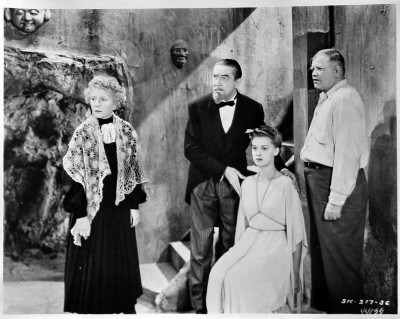
I realize that — for all their shortcomings — they not only gave Lugosi badly needed work, but they kept his spirits up by starring him (well, eight of them do) rather than just cashing in on his name like Universal was doing at this point in his career. Universal’s Night Monster (1942) is a pretty good movie and it might “star” Lugosi, but it also wastes him in a minor role. Monogram’s Black Dragons (1942) is a pretty awful movie, but it gives you 60 solid minutes of Lugosi — if little else. The true mark of a Lugosi fan is that you also love the bad movies. Plus, these movies are uniquely bad in that what you end up with are movies that feel like they were made by precocious 10-year-olds (that really is the level of logic) and starring a world-class actor trying to hold it all together by the sheer force of his will. That he almost pulls it off is the amazing thing.
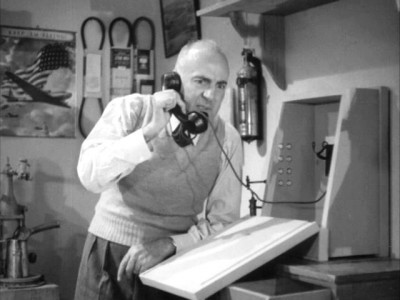
William Beaudine’s Voodoo Man (1944) is perhaps the most bizarre of the lot. It was actually the last of the series, but was released before the earlier Return of the Ape Man (1944). Lugosi plays Dr. Richard Marlowe, a man with absolutely no back-story, who has somehow located himself at a creepy old house (the usual Monogram set) in some hick town. He’s also managed to come up with an elaborate underground lair wherein he — with the help of gas station owner and voodoo high priest Nicholas (George Zucco) and a couple of tame morons (one played by John Carradine) — conducts ceremonies to bring his dead wife (Ellen Hall) back to life. Now, understand, Mrs. Marlowe is “dead only in the sense that you understand that word,” meaning that she tends to wander around with no real purpose. T
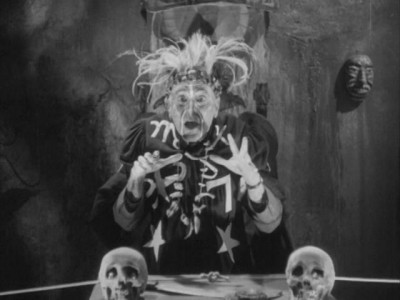
The idea is to have the god Ramboona (who Nicholas assures us “never fails,” despite much evidence to the contrary) drain the life force out of hapless pretty girl motorists and into Mrs. Marlowe. Here’s how this works: Nicholas keeps an eye out for suitable candidates — pretty and alone — and then notifies the doctor via his not-very-secret telephone system. At this point, Marlowe’s henchman set up a detour — using a “road closed” sign and some portable shrubbery — and kidnap the latest candidate. (What they do with the cars is never addressed.) Thereupon, we are treated to the absolute jaw-dropping voodoo ceremonies. Let’s put it this way, Zucco’s facial expressions alone make it worthwhile, but then there’s also his tobacco-auctioneer mumbo jumbo—not mention that hat.
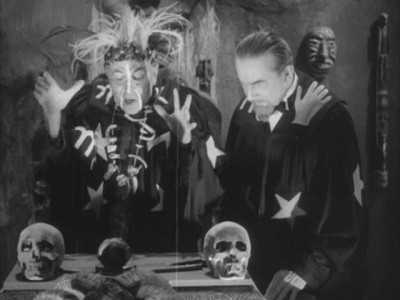
To make all this just that much more bizarre — yes, it is possible — the hero, Ralph Dawson (an incredibly obnoxious Michael Ames), is a “scenario writer” for — wait for it — Banner Pictures. Better yet, he enters the film by getting a writing assignment for this very story from Sam Katzman himself. Well, sort of, since the Great Man is only called “S.K.” and is played by character actor John Ince. That he winds up stuck in the very story he’s supposed to be writing is only the tip of the iceberg — as the movie’s final scene illustrates. No, it doesn’t make any sense, but that’s the beauty of it. The real surprise is that — dumb as all this is — it’s actually reasonably well made by the notorious William Beaudine, a man noted not so much for getting his shots in one take, but for being cool with whatever take he got. (Legend has it that he was once castigated being behind schedule and responded in shock at the idea that someone was actually waiting to see the film.)
Return of the Ape Man
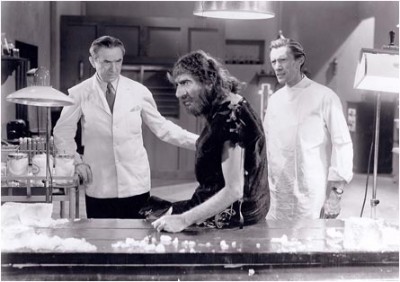
Phil Rosen’s Return of the Ape Man isn’t as remarkable, but it’s certainly no less dumb. While it would seem to be a sequel to The Ape Man, it isn’t. Apart from Lugosi’s presence, there’s no connection at all, but I guess it sounded good — somehow. The production is a strange one. It purports that its “monster” — a caveman that characters keep insisting looks like an ape, even though it doesn’t — is played by both George Zucco and Frank Moran. Well … there’s a production still that clearly shows poor old Zucco in the dopey make-up. There’s also one shot in the film of the caveman lying on a table that obviously isn’t Moran and might well be Zucco, but nearly all of the film is Moran. That was a break for Zucco, who was at least spared the indignity of the shot where the prehistoric gent is show climbing out a window and giving us a good luck at his apparently prehistoric underwear.
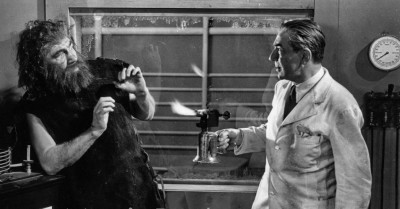
The whole — way too ambitious — idea is that Professor Dexter (Lugosi) wants to go to the arctic on the off-chance of finding a prehistoric man flash-frozen in a glacier. The idea being to take the fellow home and thaw him out — thereby proving his theories of suspended animation. (Don’t bother thinking about this.) This is all accomplished by some really old stock footage of the arctic and some rear projection of Dexter and his sidekick, Professor Gilmore (John Carradine), undoubtedly sweating up a storm in ridiculous fur outfits on a soundstage, while a pair of extras with picks swipe unenthusiastically at the “ice” on the floor.
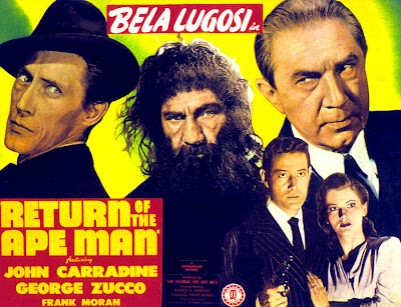
Thanks to the needs of the script, the frozen caveman shows up and is taken back to civilation — or at least Dexter’s basement lab. (Dexter’s home appears to consist of a hall, a library and this basement.) And, yes, their hirsute prize turns out to be very lively — and none too chummy — when he thaws out (with the aid of a blow-torch). Fortunately, like any well-prepared mad scientist, Dexter has a whip on the wall of the lab and with that — and the handy blow-torch — the irritable caveman is easily caged. “How are you going to get him over to the Museum of Natural History?” asks the dull-witted Gilmore — unaware that Dexter has other plans. Those plans will, of course, turn out badly. Well, it’s that kind of movie.
The Thursday Horror Picture Show will screen Voodoo Man and Return of the Ape Man Thursday, Aug. 29, at 8 p.m. in the Cinema Lounge at The Carolina Asheville and will be hosted by Xpress movie critics Ken Hanke and Justin Souther.



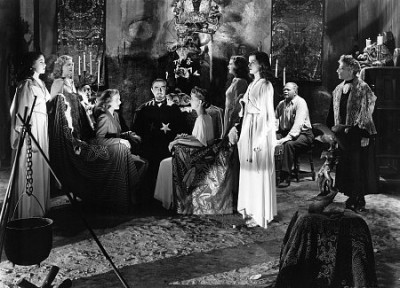
Before you comment
The comments section is here to provide a platform for civil dialogue on the issues we face together as a local community. Xpress is committed to offering this platform for all voices, but when the tone of the discussion gets nasty or strays off topic, we believe many people choose not to participate. Xpress editors are determined to moderate comments to ensure a constructive interchange is maintained. All comments judged not to be in keeping with the spirit of civil discourse will be removed and repeat violators will be banned. See here for our terms of service. Thank you for being part of this effort to promote respectful discussion.